|
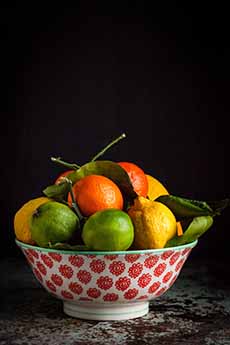
[1] Citrus: the jewels of winter fruit (photo © Heather Gill | Wesual | Unsplash).
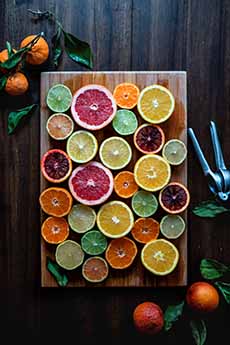
[2] Mixed citrus slices, garnishes for beverages and plated foods (photo © Edgar Castrejon | Unsplash).
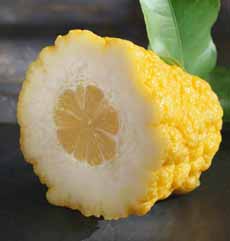
[3] Citron, one of the three original citrus fruits (along with mandarin orange and pomelo) from which all other citrus was bred (photo courtesy San Pellegrino Fruit Beverages).
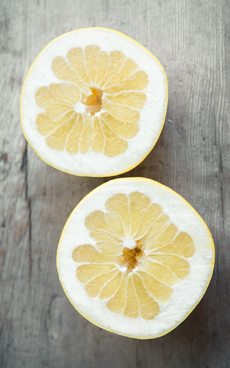
[4] Pomelo, an ancestor of grapefruit (photos © #4 and #7 Good Eggs).
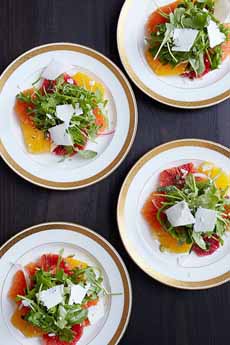
[5] Winter salad of mixed citrus, arugula and ricotta salata. Here’s the recipe from Saveur.
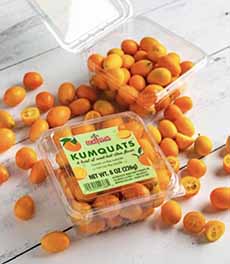
[6] Kumquats are another winter citrus. They were historically their own genus (Citrus fortunella) with multiple species, but today they are often classified as Citrus japonica. There are also related hybrids† (photo © Melissa’s Produce).
|
|
Through Mother Nature and breeding by mankind, some plants and animals have grown larger and larger over time. Big beefsteak tomatoes evolved from a fruit the size of a cherry tomato; the original pig was the size of a cat.
The large citrus fruits of today evolved over millions of years from small, edible berries. Their origin is believed to be either southeastern Asia or Australia [source].
The three original species in the citrus genus—citron (photo #1), mandarins and pomelo/pummelo—have been hybridized into most of the modern commercial citrus fruits we know.
Within the last few thousand years, all common citrus fruits (grapefruit, lemons, limes, sweet oranges, etc.) were created by crossing those original species.
> The year’s 40+ citrus holidays are below.
> The history of grapefruits.
> The history of lemons.
> The history of limes.
> The history of oranges.
> The history of mandarins.
> The difference between mandarins and oranges.
> The different types of lemons: a photo glossary.
> The different types of limes: a photo glossary.
CELEBRATE WINTER CITRUS
The winter months deliver certain varieties of citrus that aren’t available in other seasons.
Blood oranges, cara cara oranges and ruby red grapefruit are among our favorite fruits. Here, from Good Eggs of San Francisco, are the California-grown fruits you should add to your shopping cart.
You can enjoy these beauties in:
Beverages (cocktails, juice, spritzers)
Cakes (recipe), bars (substitute blood orange in lemon bars), tarts
Candied peel (recipe)
Desserts (try brûlée [broiled] citrus halves or slices; make citrus sorbet)
Fruit salads (recipes)
Garnishes
Green salads
Hand fruits*
Sauces (juice and zest)
Seafood recipes
Vinaigrettes
Yogurt
A NOTE ABOUT MANDARINS
Just as blood, cara cara and navel are different varieties of sweet oranges in the citrus genus (Citrus × sinensis), mandarins are a separate species.
Mandarins (Citrus reticulata) are loose-skinned fruits with segments that separate easily. Some of the better-known varieties are clementines, dancys, minneolas, tangerines and satsumas.
While many people call them mandarin oranges—erroneously combine both species—the correct name is mandarin or mandarins.
Think of them as cousins to oranges; and think of clementines, tangerines, satsumas and other mandarins as siblings.
MEET THE CITRUS
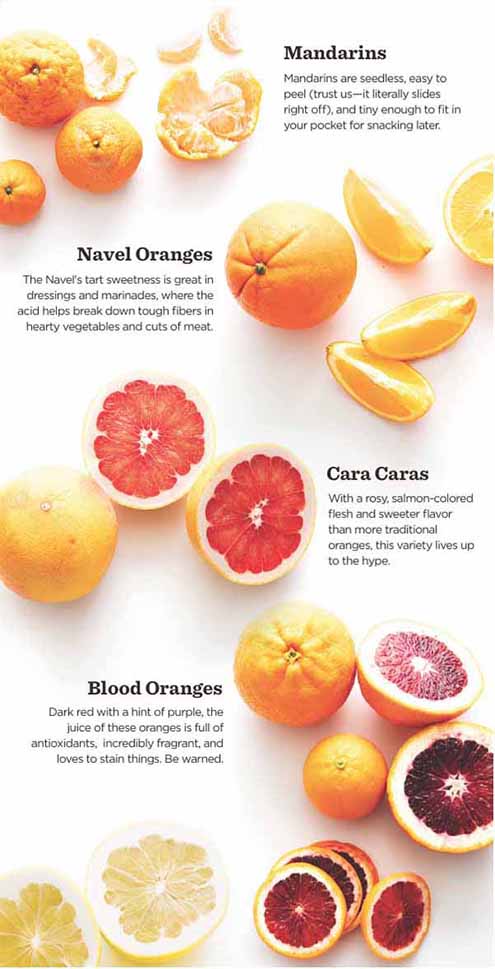
[7] Major types of U.S. citrus.
|
|
THE YEAR’S 40+ CITRUS HOLIDAYS
|
Including Citrus Cocktails
|
|
GENERAL HOLIDAYS
January is National Citrus Month
January, 3rd Sunday: National Fresh Squeezed Juice Week begins
March 1: National Sunkist Citrus Day
April 4: Vitamin C Day
October 25: Sourest Day
GRAPEFRUIT HOLIDAYS
February is National Grapefruit Month
May 22: World Paloma Day
LEMON HOLIDAYS
March, 3rd Thursday: National Oranges and Lemons Day
March 29: Lemon Chiffon Cake Day
May, 1st Sunday: National Lemonade Day
May 17: Plant a Lemon Tree Day
June: National Lemon Month
June 6: National Long Island Iced Tea Day
June 22: National Limoncello Day
July 23: National Lemon Day
August 15: National Lemon Meringue Pie Day
August 25: National Whiskey Sour Day
August 29 National Lemon Juice Day
October 15: National Lemon Bar Day
November 29: National Lemon Cream Pie Day
December 15: National Lemon Cupcake Day
|
LIME HOLIDAYS
February, 1st Saturday: National Pisco Sour Day
February 22: National Margarita Day
March 10: International/National Lime Day
May 7: National Cosmopolitan Day
June 9: International Dark ‘n Stormy Day
June 27: National Singapore Sling Day
July 11: National Mojito Day
July 19: National Daiquiri Day
August 30: National Mai Tai Day
September 13: National Caipirinha Day
September 26: National Key Lime Day
ORANGES & MANDARINS HOLIDAYS
February 15: National Clementine Day
March 20: National Mandarin Orange Day
March, 3rd Thursday: National Oranges and Lemons Day
May 4: National Candied Orange Peel Day
May 4 National Orange Juice Day
May 16: National Mimosa Day
June 21: National Tequila Sunrise Day
June 27: National Orange Blossom Day
July 14: National Grand Marnier Day
July 15: National Orange Chicken Day
August 14: National Creamsicle Day
November 8: National Harvey Wallbanger Day
December 14: National Screwdriver Day
|
________________
*Hand fruit is the industry term for fruit that can be eaten from the hand: apples, bananas, oranges, pears, etc. Fruits that are not hand fruit: coconuts, cranberries, melons, pineapples, quinces, etc.
†Though not strictly Citrus japonica, many hybrids with kumquats exist including calamondin (mandarin x kumquat), limequat (lime × kumquat), orangequat (orange × kumquat), and yuzuquat (yuzu × kumquat).
CHECK OUT WHAT’S HAPPENING ON OUR HOME PAGE, THENIBBLE.COM.
|









